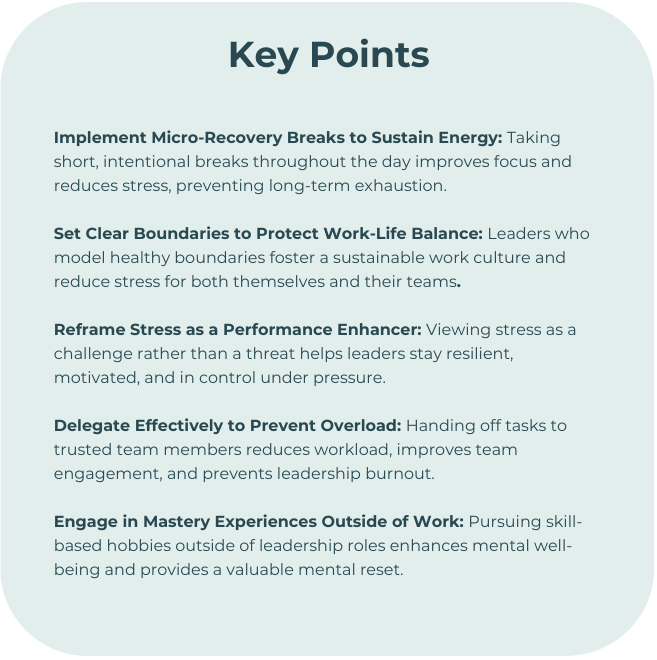Preventing Burnout: A Guide for Leaders
What to Consider When Reading
How can you apply recovery-based leadership strategies to protect your mental resilience?
What small adjustments can you make today to reduce burnout while maintaining high performance?
As a leader, you are responsible for guiding your team, making critical decisions, and maintaining the vision of your organization. But leadership comes with intense pressures, and if you're not careful, burnout can creep in—affecting your well-being, decision-making, and even the morale of your team. Burnout isn’t just about feeling exhausted; it’s a state of emotional, mental, and sometimes physical depletion that can make even the most passionate leader feel disengaged and overwhelmed.
So, how do you avoid burnout while maintaining high performance as a leader? Here are research-backed strategies designed to help leaders sustain their energy, mental resilience, and effectiveness over the long haul.
1. Implement Micro-Recovery Breaks to Sustain Energy
Leaders often feel the pressure to push through exhaustion, but research shows that taking short, deliberate breaks throughout the day can significantly improve focus and reduce stress. Micro-recovery breaks—such as deep breathing exercises, a five-minute walk, or brief mindfulness moments—help reset your nervous system and sustain energy levels.
Try this: Schedule at least three micro-recovery breaks in your day. Use these moments to step away from your desk, stretch, or simply take a few deep breaths. Studies suggest that even brief recovery periods can lower cortisol levels and improve long-term resilience.
2. Set Clear Boundaries to Protect Work-Life Balance
Leaders often struggle with blurred boundaries between work and personal time. This constant availability can quickly lead to burnout. Establishing firm work-life boundaries is essential for maintaining mental and emotional health.
Try this: Designate tech-free hours in your day—perhaps an hour before bedtime or during meals. Encourage your team to respect these boundaries as well. Research in organizational psychology shows that leaders who model healthy boundaries create more sustainable work cultures, reducing burnout for both themselves and their teams.
3. Reframe Stress as a Performance Enhancer
Burnout is often the result of chronic stress that isn’t managed effectively. However, stress itself isn’t inherently harmful—it’s how we perceive and respond to it that matters. Studies on stress mindset theory show that when leaders view stress as a performance enhancer rather than a threat, they experience less exhaustion and greater resilience.
Try this: The next time you feel overwhelmed, reframe your stress by telling yourself: This is a challenge, not a threat. I can handle this, and I’ll grow from it. Research suggests that this simple shift in perspective can lower burnout rates and increase performance under pressure.
4. Delegate Effectively to Prevent Overload
One of the most common causes of leadership burnout is taking on too much. Many leaders feel they need to do everything themselves, but effective delegation not only lightens the workload—it also empowers your team and boosts their development.
Try this: Identify one task this week that you can delegate. Be clear about expectations, provide the necessary support, and trust your team to execute. Studies show that leaders who delegate effectively experience lower stress and higher job satisfaction.
5. Use Reflective Journaling to Process Leadership Challenges
Burnout isn’t just about workload—it’s also about emotional exhaustion. Research indicates that reflective journaling can help leaders process challenges, gain perspective, and regulate stress more effectively.
Try this: Spend five minutes at the end of each day writing about what went well, what challenged you, and what you learned. This practice helps offload mental clutter and promotes a sense of control over your leadership journey.
6. Engage in Mastery Experiences Outside of Work
Leaders who engage in non-work-related mastery experiences—such as learning a new skill, playing a musical instrument, or practicing a sport—report lower levels of burnout and higher overall well-being. These activities provide a mental reset and reinforce a sense of competence beyond work.
Try this: Identify one activity outside of work that challenges you in a positive way—whether it’s painting, hiking, or martial arts. Engaging in hobbies that require skill-building has been shown to reduce stress and increase fulfillment.
7. Leverage Social Support to Maintain Resilience
Isolation is a major risk factor for burnout. Leaders who regularly connect with trusted peers, mentors, or professional networks experience greater resilience and emotional well-being.
Try this: Schedule one meaningful conversation per week with a mentor, colleague, or coach. Whether it’s for advice, debriefing a challenge, or simply sharing experiences, these connections serve as a powerful buffer against burnout.
8. Adopt a “Recovery First” Leadership Mindset
Burnout prevention isn’t about working harder—it’s about working smarter by prioritizing recovery. Leaders who actively invest in their well-being set the tone for their organizations, fostering a healthier and more sustainable work culture.
Try this: Shift your mindset from “I’ll rest when everything is done” to “Recovery is a leadership priority.” Research shows that leaders who prioritize recovery experience higher long-term performance, creativity, and decision-making quality.
Conclusion
Avoiding burnout as a leader isn’t about simply reducing workload—it’s about actively building resilience through smart, sustainable habits. By integrating micro-recovery breaks, setting clear boundaries, reframing stress, and engaging in mastery experiences, you can protect your well-being while leading at your best.
Effective leadership requires energy, clarity, and emotional stamina—all of which are preserved when burnout is actively prevented. Remember, taking care of yourself isn’t a luxury—it’s a necessity for long-term success.
Want to Learn More? If you’re looking for personalized strategies to sustain high performance while avoiding burnout, consider booking a consultation to explore advanced mental resilience techniques tailored to your leadership journey.

